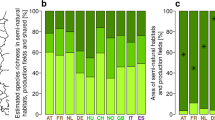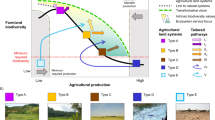Abstract
Agricultural intensification drives biodiversity loss and shapes farmers’ profit, but the role of legacy effects and detailed quantification of ecological–economic trade-offs are largely unknown. In Europe during the 1950s, the Eastern communist bloc switched to large-scale farming by forced collectivization of small farms, while the West kept small-scale private farming. Here we show that large-scale agriculture in East Germany reduced biodiversity, which has been maintained in West Germany due to >70% longer field edges than those in the East. In contrast, profit per farmland area in the East was 50% higher than that in the West, despite similar yield levels. In both regions, switching from conventional to organic farming increased biodiversity and halved yield levels, but doubled farmers’ profits. In conclusion, European Union policy should acknowledge the surprisingly high biodiversity benefits of small-scale agriculture, which are on a par with conversion to organic agriculture.
This is a preview of subscription content, access via your institution
Access options
Access Nature and 54 other Nature Portfolio journals
Get Nature+, our best-value online-access subscription
$29.99 / 30 days
cancel any time
Subscribe to this journal
Receive 12 digital issues and online access to articles
$119.00 per year
only $9.92 per issue
Buy this article
- Purchase on Springer Link
- Instant access to full article PDF
Prices may be subject to local taxes which are calculated during checkout




Similar content being viewed by others
References
Tscharntke, T., Klein, A. M., Kruess, A., Steffan-Dewenter, I. & Thies, C. Landscape perspectives on agricultural intensification and biodiversity — ecosystem service management. Ecol. Lett. 8, 857–874 (2005).
Smil, V. Detonator of the population explosion. Nature 400, 415 (1999).
Foley, J. et al. Global consequences of land use. Science 309, 570–574 (2005).
Kesternich, I., Siflinger, B., Smith, P. J. & Winter, K. J. The effects of World War II on economic and health outcomes across Europe. Rev. Econ. Stat. 96, 103–118 (2014).
Kareiva, P., Watts, S., McDonald, R. & Boucher, T. Domesticated nature: shaping landscapes and ecosystems for human welfare. Science 316, 1866–1869 (2007).
Ellis, E. C. et al. Used planet: a global history. Proc. Natl Acad. Sci. USA 110, 7978–7985 (2013).
Iordachi, C. & Bauerkamper, A. (eds) The Collectivization of Agriculture in Communist Eastern Europe: Comparison and Entanglements (Central European Univ. Press, Budapest, 2014).
Schöne, J. in The Collectivization of Agriculture in Communist Eastern Europe: Comparison and Entanglements (eds Iordachi, C. & Bauerkamper, A.) 147–180 (Central European Univ. Press, Budapest, 2014).
Baessler, C. & Klotz, S. Effects of changes in agricultural land-use on landscape structure and arable weed vegetation over the last 50 years. Agric. Ecosyst. Environ. 115, 43–50 (2006).
Fischer, C. et al. Mixed effects of landscape structure and farming practice on bird diversity. Agric. Ecosyst. Environ. 141, 119–125 (2011).
Petrick, M. & Zier, P. Regional employment impacts of Common Agricultural Policy measures in Eastern Germany: a difference-in-differences approach. Agric. Econ. 42, 183–193 (2011).
Kleijn, D., Berendse, F., Smit, R. & Gilissen, N. Agri-environment schemes do not effectively protect biodiversity in Dutch agricultural landscapes. Nature 413, 723–725 (2001).
Schneider, M. K. et al. Gains to species diversity in organically farmed fields are not propagated at the farm level. Nat. Commun. 5, 4151 (2014).
Tuck, S. L. et al. Land-use intensity and the effects of organic farming on biodiversity: a hierarchical meta-analysis. J. Appl. Ecol. 51, 746–755 (2014).
Gabriel, D. et al. Scale matters: the impact of organic farming on biodiversity at different spatial scales. Ecol. Lett. 13, 858–869 (2010).
Barański, M. et al. Higher antioxidant and lower cadmium concentrations and lower incidence of pesticide residues in organically grown crops: a systematic literature review and meta-analyses. Br. J. Nutr. 112, 794–811 (2014).
Benton, T. G., Vickery, J. A. & Wilson, J. D. Farmland biodiversity: is habitat heterogeneity the key? Trends Ecol. Evol. 18, 182–188 (2003).
Marshall, E. J. P., West, T. M. & Kleijn, D. Impacts of an agri-environment field margin prescription on the flora and fauna of arable farmland in different landscapes. Agric. Ecosyst. Environ. 113, 36–44 (2006).
Fischer, J. et al. Should agricultural policies encourage land sparing or wildlife-friendly farming? Front. Ecol. Environ. 6, 380–385 (2008).
Perfecto, I. & Vandermeer, J. The agroecological matrix as alternative to the land-sparing/agriculture intensification model. Proc. Natl Acad. Sci. USA 107, 5786–5791 (2010).
Mendenhall, C. D., Karp, D. S., Meyer, C. F. J., Hadly, E. A. & Daily, G. C. Predicting biodiversity change and averting collapse in agricultural landscapes. Nature 509, 213–217 (2014).
Thiele, H. & Brodersen, C. M. Differences in farm efficiency in market and transition economies: empirical evidence from West and East Germany. Eur. Rev. Agric. Econ. 26, 331–347 (1999).
Happe, K., Balmann, A., Kellermann, K. & Sahrbacher, C. Does structure matter? The impact of switching the agricultural policy regime on farm structures. J. Econ. Behav. Organ. 67, 431–444 (2008).
Batary, P., Baldi, A., Kleijn, D. & Tscharntke, T. Landscape-moderated biodiversity effects of agri-environmental management: a meta-analysis. Proc. R. Soc. London Ser. B 278, 1894–1902 (2011).
Seufert, V., Ramankutty, N. & Foley, J. A. Comparing the yields of organic and conventional agriculture. Nature 485, 229–232 (2012).
Seufert, V. & Ramankutty, N. Many shades of gray — the context-dependent performance of organic agriculture. Sci. Adv. 3, e1602638 (2017).
Clough, Y., Kruess, A. & Tscharntke, T. Organic versus conventional arable farming systems: functional grouping helps understand staphylinid response. Agric. Ecosyst. Environ. 118, 285–290 (2007).
Duffy, M. Economies of size in production agriculture. J. Hunger Environ. Nutr. 4, 375–392 (2009).
Crowder, D. W. & Reganold, J. P. Financial competitiveness of organic agriculture on a global scale. Proc. Natl Acad. Sci. USA 112, 7611–7616 (2015).
Reganold, J. P. & Wachter, J. M. Organic agriculture in the twenty-first century. Nat. Plants 2, 1–8 (2016).
Batáry, P., Dicks, L. V., Kleijn, D. & Sutherland, W. J. The role of agri-environment schemes in conservation and environmental management. Conserv. Biol. 29, 1006–1016 (2015).
Hill, B. & Bradley, B. D. Comparison of Farmers’ Incomes in the EU Member States (European Commission, DG Internal Policies, 2015).
Borenstein, M., Hedges, V. L., Higgins, P. T. J. & Rothstein, R. H. Introduction to Meta-analysis (Wiley, Hoboken, NJ, 2009).
Colwell, R. K. EstimateS: statistical estimation of species richness and shared species from samples version 8.0 http://purl.oclc.org/estimates (2006).
Gotelli, N. J. & Colwell, R. K. Quantifying biodiversity: procedures and pitfalls in the measurement and comparison of species richness. Ecol. Lett. 4, 379–391 (2001).
Sutcliffe, L. M. E. et al. Harnessing the biodiversity value of Central and Eastern European farmland. Divers. Distrib. 21, 722–730 (2015).
Duelli, P., Obrist, M. K. & Schmatz, D. R. Biodiversity evaluation in agricultural landscapes: above-ground insects. Agric. Ecosyst. Environ. 74, 33–64 (1999).
KTBL Online Verfahrensrechner des Kuratorium für Technik und Bauwesen in der Landwirtschaft [Online calculator of Association for Technology and Structures in Agriculture] http://daten.ktbl.de/vrpflanze/home.action (2015).
Agravis Pflanzenschutz- und Schädlingsbekämpfungsmittel, Preisliste 2014 [Pesticides, Price List 2014] (Agravis Raiffeisen AG, 2014).
Landi Bayer Detailpreisliste 2014 [Bayer Price List 2014] (LANDI Bachtel, Landw. Genossenschaft, 2014).
Schweiger Pflanzenschutz Preisliste Frühjahr 2014 [Pesticide Pricelist Spring 2014] (Schweiger Agrar-, Bau-, Brennstoffhandel, 2014).
TopAgrar Getreideherbizide gegen Unkräuter und Ungräser [Cereal Herbicides against Weeds and Weed Grasses] (Landwirtschaftsverlag Münster, 2013).
Köpke, U. & Küpper, P. Marktanteile im Segment Bio-Lebensmittel – Folgen und Folgerungen [Market Shares in the Organic Food Segment – Consequences and Conclusions] (Institut für Organischen Landbau, 2012).
Bates, D., Maechler, M., Bolker, B. & Walker, S. Fitting linear mixed-effects models using lme4. J. Stat. Softw. 67, 1–48 (2015).
R Development Core Team R: a language and environment for statistical computing version 3.2.0 (2015).
Legendre, P. & Legendre, L. Numerical Ecology (Elsevier Science, Amsterdam, 1998).
Bartoń, K. MuMIn: multi-model inference R package version 1.14.0 (2015).
Viechtbauer, W. Conducting meta-analyses in R with the metafor package. J. Stat. Softw. 36, 1–48 (2010).
Acknowledgements
This paper is the product of the project ‘Biodiversity and associated ecosystem services in small- vs. large-scale agriculture’ by the German Research Foundation (DFG BA 4438/1-1). We are grateful to L. Ádám for the identification of rove beetles, and to D.W. Crowder, A. Iverson and D. Kleijn for valuable comments on the manuscript. P.B. was supported by the Economic Development and Innovation Operational Programme of Hungary (GINOP–2.3.2–15–2016–00019).
Author information
Authors and Affiliations
Contributions
P.B. and T.T. conceived the study; P.B., C.F., O.M. and T.T. developed the study; P.B., R.G., F.R., S.F., C.G., A.-K.H., K.K., D.M., V.R. and A.W. collected data; R.G. and P.C. identified arthropods; P.B. analysed data with substantial input from C.F.D.; and P.B. wrote the paper with substantial input from all authors.
Corresponding author
Ethics declarations
Competing interests
The authors declare no competing financial interests.
Additional information
Publisher’s note: Springer Nature remains neutral with regard to jurisdictional claims in published maps and institutional affiliations.
Electronic supplementary material
Supplementary Information
Supplementary Figures and Supplementary Tables
Rights and permissions
About this article
Cite this article
Batáry, P., Gallé, R., Riesch, F. et al. The former Iron Curtain still drives biodiversity–profit trade-offs in German agriculture. Nat Ecol Evol 1, 1279–1284 (2017). https://doi.org/10.1038/s41559-017-0272-x
Received:
Accepted:
Published:
Issue Date:
DOI: https://doi.org/10.1038/s41559-017-0272-x
This article is cited by
-
Plant species richness increase across crop field–dry grassland edges masks diverging patterns in generalists and specialists
Landscape Ecology (2024)
-
Projected landscape-scale repercussions of global action for climate and biodiversity protection
Nature Communications (2023)
-
Landscape homogenisation and simplified butterfly community structure go on par across Northern Austria
Landscape Ecology (2023)
-
Economics of field size and shape for autonomous crop machines
Precision Agriculture (2023)
-
The secret life of wild animals revealed by accelerometer data: how landscape diversity and seasonality influence the behavioural types of European hares
Landscape Ecology (2023)



